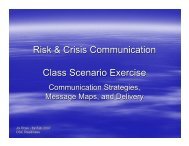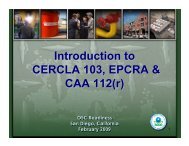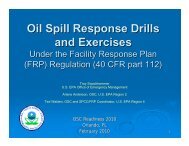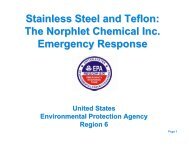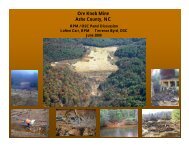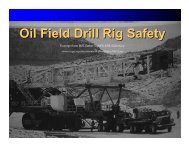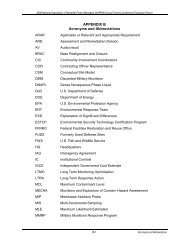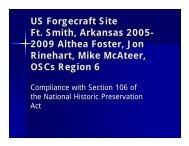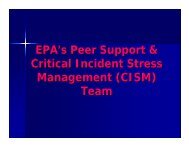OSC 2007 Evaluation Report
OSC 2007 Evaluation Report
OSC 2007 Evaluation Report
Create successful ePaper yourself
Turn your PDF publications into a flip-book with our unique Google optimized e-Paper software.
<strong>2007</strong> <strong>OSC</strong> Readiness Training Program <strong>Evaluation</strong> <strong>Report</strong><br />
Advanced Hazard Identification and Categorization<br />
Instructors: Doug Ferguson, EPA Region 7<br />
Randy Schademann, EPA Region 7<br />
This 1-day advanced course focused on specific techniques that <strong>OSC</strong>s can use when responding to<br />
incidents involving abandoned containers or other materials of unknown composition. Participants were<br />
expected to be proficient at field chemical identification techniques before they took this course. By<br />
taking the course, participants achieved the following objectives:<br />
• Developed an understanding of major chemical families, their properties, and the techniques used<br />
to identify them.<br />
• Applied a step-by-step approach to categorize the major hazards of wastes typically encountered<br />
at EPA responses. This process helped participants decide whether and what type of further<br />
analysis of the material was needed, and to determine whether bulking the wastes was possible.<br />
• Used wet chemical and electronic instrumentation to identify many materials of unknown<br />
composition, or applied basic hazard categorization to determine the general chemical family to<br />
which these materials belong (such as alcohol, ketone, acid, base, and hydrocarbon).<br />
• Explored practical applications for advanced field chemical identification by reviewing a variety<br />
of case studies that had successfully applied the methods. A discussion was included about<br />
potential cost savings as a result of using reduced analytical services and a decrease in time spent<br />
on tasks.<br />
The instructional methodology for this course included lecture, case studies, and group exercises.<br />
Number of Participants Who<br />
Pre-registered<br />
Participation and Average Grade<br />
Number of Participants Who<br />
Signed Course Roster<br />
Number of <strong>Evaluation</strong><br />
Forms Submitted<br />
Average<br />
Grade<br />
37 35 22 5*<br />
* The grade displayed is the average of the grades provided on the evaluation forms, where<br />
1 = Poor, 2 = Fair, 3 = Good, 4 = Very Good, and 5 = Excellent.<br />
C-6 Comments about Individual Training Courses



